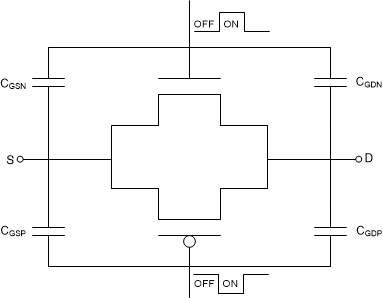SCDS443C October 2022 – October 2024 TMUX7201 , TMUX7202
PRODUCTION DATA
- 1
- 1 Features
- 2 Applications
- 3 Description
- 4 Pin Configuration and Functions
-
5 Specifications
- 5.1 Absolute Maximum Ratings
- 5.2 ESD Ratings
- 5.3 Thermal Information
- 5.4 Recommended Operating Conditions
- 5.5 Source or Drain Continuous Current
- 5.6 ±15V Dual Supply: Electrical Characteristics
- 5.7 ±15V Dual Supply: Switching Characteristics
- 5.8 ±20V Dual Supply: Electrical Characteristics
- 5.9 ±20V Dual Supply: Switching Characteristics
- 5.10 44V Single Supply: Electrical Characteristics
- 5.11 44V Single Supply: Switching Characteristics
- 5.12 12V Single Supply: Electrical Characteristics
- 5.13 12V Single Supply: Switching Characteristics
- 5.14 Typical Characteristics
- 6 Parameter Measurement Information
- 7 Detailed Description
- 8 Application and Implementation
- 9 Device and Documentation Support
- 10Revision History
- 11Mechanical, Packaging, and Orderable Information
Package Options
Mechanical Data (Package|Pins)
- RQX|8
Thermal pad, mechanical data (Package|Pins)
Orderable Information
7.3.7 Ultra-Low Charge Injection
Figure 7-1 shows how the TMUX720x devices have a transmission gate topology. Any mismatch in the stray capacitance associated with the NMOS and PMOS causes an output level change whenever the switch is opened or closed.
 Figure 7-1 Transmission Gate Topology
Figure 7-1 Transmission Gate TopologyThe TMUX720x contains specialized architecture to reduce charge injection on the Drain (Dx). To further reduce charge injection in a sensitive application, a compensation capacitor (Cp) can be added on the Source (S). By design, the excess charge from the switch transition will be pushed into the compensation capacitor on the Source (S) instead of the Drain (D). As a general rule, Cp should be 20x larger than the equivalent load capacitance on the Drain (D). Figure 7-2 shows charge injection variation with different compensation capacitors on the Source side. This plot was captured on the TMUX7219 as part of the TMUX72xx family with a 100pF load capacitance.
 Figure 7-2 Charge Injection Compensation
Figure 7-2 Charge Injection Compensation